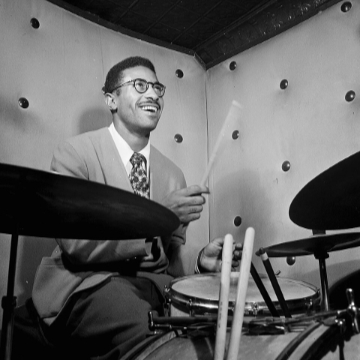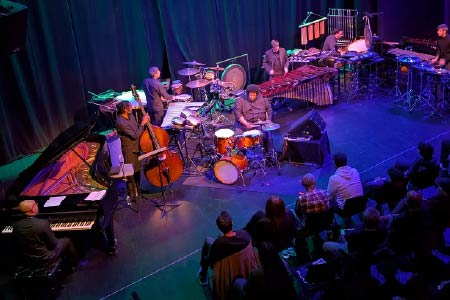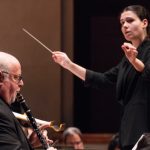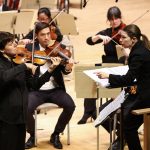November 21, 2025
Baldwin Auditorium, Duke University
Durham, North Carolina — USA
Tyshawn Sorey Trio; Sandbox Percussion
Tyshawn SOREY: Cogitations (2024), incorporating (in this performance):
George LEWIS: “Le témoignage des lumières”
Julius EASTMAN: “Joy Boy”
Omar CLAY & Warren SMITH: “Morning/Midday”
Christopher Hill | 24 NOV 2025
For some years, Duke Arts has been bringing outstanding solo and chamber musicians to Baldwin Hall in Durham. In 2019, your reviewer saw Daniil Trifonov in recital there, and I’ve returned for a number of other outstanding concerts. This season, Duke Arts’ 80th brings some of the best traditional chamber ensembles in the world to Durham via the Chamber Arts series—for example, the Takacs and Doric String Quartets. A contrasting series, Duke Arts Presents, features a wide range of music but emphasizes the new and hip rather than the traditional.
On Friday, November 21, as part of Duke Arts Presents, the Tyshawn Sorey Trio and Sandbox Percussion, a quartet, teamed up to present a recent percussion septet of Sorey’s creation entitled Cogitations. The concert was billed as a centenary memorial to jazz giant Max Roach (1924–2007).

Max Roach, ca. 1947.(credit: William P. Gottlieb/Library of Congress)
If you’re not familiar with Sorey, you may be interested to know that in 2024, he received the Pulitzer Prize for music. If you know the name Max Roach but are not all that familiar with his work, see below at the end of this review. If you don’t happen to know Sandbox Percussion, allow me to inform you that when it comes to percussion quartets, they are the high-priced spread. Their 2020 album, And That One Too, was well-received. Their 2021 album, Seven Pillars, a collaboration with South Carolina composer Andy Akiho, got raves and a 2022 Grammy nomination. Akiho’s piece itself became a finalist for the 2022 Pulitzer Prize in music—heady stuff. Andy Akiho subsequently began releasing his own albums, which received Grammy nominations in 2023 and 2024 and two hold-in-your-hand Grammys in 2025. Sandbox Percussion will be collaborating with Akiho on a new work in 2026. That, together with their current collaboration with Tyshawn Sorey, may bring this group of super-virtuosos back into contention for awards.
But enough about awards, which basically are a way to monetize music. Music itself is just about music. So what of Cogitations? What was the performance like?
First, let’s describe the instrumentation. The piano, bass, and drum kit of the Tyshawn Sorey Trio was located on the far left side of the stage. The rest of the stage was filled with a kitchen-sink full of Sandbox percussion instruments, many of which were not visible to the audience since they were stationed behind larger instruments, such as two vibraphones, a xylophone, two drum kits, and a large marimba. Also visible were tubular bells, wood blocks, a bamboo “curtain,” gongs, a musical saw, and tuned metal plates. Many more instruments were audible, however, though not visible. In keeping with modern percussive technologies, quite a few, perhaps most, of the mentioned instruments were also played in non-percussive ways, with bows, (possibly) amplified scrapers, and so on. In short, there was no shortage of tuned or untuned timbres, and no five-minute segment of Cogitations used just the same tone colors as any other five-minute segment. That said, the tone colors in some segments were deliberately reminiscent of previous segments. The piece had some sense of shape.

Stage layout for the Max Roach centenary concert.
The second thing you should know about Cogitations concerns its length. Duke Arts was careful to warn potential audience members in its advertising and program that Cogitations would last 100 unbroken minutes. Bruckner himself would have gone to bed by then. In the event, the auditorium was not packed; perhaps 250 people were present. And credit the Boomer generation for its aesthetic appetites: at least half of those 250 auditors (your reviewer included) were probably retirees. Any overlap between Tyshawn Sorey’s life experiences and theirs would have to be largely aspirational, right?
Well…not really. It would be more apposite to say that any overlap between Sorey’s life and theirs would be imaginative. Because when a piece lasts one hundred minutes and its structure changes with every performance, you’re kind of on your own as a listener, you’re your very own Magical Mystery Tour guide. Further, only one three-minute segment in this iteration of Cogitations had a sustained dance beat. About six more minutes used tasty, sophisticated, jazz ballad material. The other ninety-one minutes were senza misura, beatless, aleatoric rhythm stuff that eschewed any sense of periodic propulsion. That may sound negative, I know. But in truth, Cogitations is not just a sequence of textures and free rhythm patterns. It is dramatic music that can be heard as inspirational, depending on how imaginatively you listen.
The third thing to know about Cogitations is that Sorey prefaced the performance with an extensive commentary, which ended with the words, “See you on the other side.” That suggested to your reviewer that the proscenium was best forgotten here. For the next one hundred minutes, all of us on both sides of the proscenium were going to be hard at work.
The best received of Sorey’s opening comments came not at the end, but earlier, at which point the audience interrupted him with hearty applause. What he had said was that because Cogitations is different in every performance, members of the audience tonight were getting a uniquely crafted sound experience, one that would never be heard again. Gosh! Talk about value for money! Applause burst forth.
Sorey also explained that Cogitations, besides being a piece in and of itself, is also a framework into which other pieces can be inserted. Friday night, the pieces to be inserted were (in performance order) George Lewis’s “Le témoignage des lumières,” Julius Eastman’s “Joy Boy,” and Omar Clay and Warren Smith’s “Morning/Midday.” I’ll return to this below.
The fourth thing to know is that the ratio of euphony to agitation to cacophony in Sorey’s piece is about 5 to 4 to 1. If you wish, you can hear the work as a cosmic journey, in which the many episodes of euphony manifest something deeply beautiful about the world, and episodes of din and cacophony signal fundamental cyclic processes that arise powerfully from, say, the bowels of the earth, if not from the skies above. Long stretches of aleatoric rhythms can be heard, for example, as rhythms of weeds in the gusting wind, or as eruptions able to fell forests. Then, at a certain point, these sounds become a background for high cries, suggesting the presence of animal life, of suffering. The piece, as played on Friday, ended with a long series of modally (mildly) dissonant bell strokes, perhaps intended as a sort of absolution. Though the series of bell strokes was extended, it was not, in your reviewer’s view, too long but just right for a hundred-minute piece. As said before, with Cogitations, every listener is free to write their own intertitles.
So what about the insertions? Unfortunately, your reviewer is not familiar with the three named pieces. But what I can say is that Cogitations seemed to retreat from its cosmic rhetoric, somewhat suddenly and somewhat incongruously, for two attractive but more-or-less standard jazz ballads, a marimba interlude, and a sunny Caribbean dance, almost a bossa nova. That’s four things, not three, so I’m not sure exactly what was what. Except for the marimba interlude, however, the sound world of these pieces was so different from the rest of Cogitations that it seemed like somebody with the remote had switched channels.
If that bothered the audience, all was forgiven after the final series of meditative bell chimes. The performers received a well-deserved standing ovation, with multiple bows.
That ends the concert review. But, as mentioned at the opening, the Friday concert was billed as a centenary celebration of Max Roach’s birth. Perhaps we can celebrate that here as well. In the words of a Duke Arts blurb, this concert honors “the legendary jazz innovator with a bold, contemporary tribute that celebrates Roach’s radical artistry and enduring influence.” Your reviewer can think of three ways Roach was celebrated in the concert. First, by being ambitious and imaginatively innovative. Second, by using high cymbal sounds extensively (see below). And third, by embedding a piece, “Morning/Midday,” that was first played by an all-percussion ensemble Roach founded in 1970. But was Roach truly “imaginatively innovative,” or is that phrase an example of canned enthusiasm? What did Roach really do?
Well, prior to Roach, influential drummers like Cozy Cole and Gene Krupa established hot jazz and swing styles in which the bass drum keeps the beat. One of Max Roach’s first bebop innovations was to move the beat from the drumkit’s bass drum to its hi-hat and cymbal, from low to high, from bump to shimmer: a revolutionary move at the time. More importantly, in his group work with Dizzy Gillespie, Charlie Parker, and Bud Powell, Roach changed the role of the drummer from that of a timekeeper with flashy solos to that of a jazz artist interacting in real time with the other players, backing them with complex patterns built on matrices of unconventional off-beats, new tone colors, and responsive change-ups. This was as radical a reinvention of jazz drumming as Charlie Parker’s use of the upper overtone series was of jazz sax. Krupa, Buddy Rich, and others could boast superb techniques and coordination. Roach had all that plus a powerful musical imagination that allowed him to layer time and to play multiple layers at once. That really was “radical artistry,” as the blurb claims. Thereafter, decade by decade, Roach never stopped searching and finding. He never stopped innovating. And he changed jazz more than once. Happy 101, Mr. Roach. ■
EXTERNAL LINKS:
- Duke Arts: arts.duke.edu
- Tyshawn Sorey Trio: tyshawnsorey.com
- Sandbox Percussion: sandboxpercussion.com

Read more by Christopher Hill.







.png)